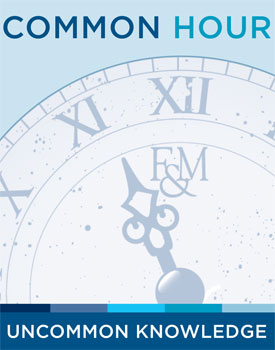Assistant Campus Life Editor
While each Common Hour may only last one hour, it takes months of planning, the work of countless faculty, staff, students, and approximately 880 slices of pizza to put it all together.
At Common Hour, a weekly event in which speakers come to F&M to discuss controversial ideas, food for thought takes on a new meaning as the F&M community gathers to discuss issues while eating their way through the pizza and apples that are supplied at most Common Hour events.
Since it was started by F&M faculty three years ago, Common Hour has grown to encompass all parts of the College. This year, Common Hour has an average attendance of 500 people each week.
“I really like that this has become something for the entire College community,” said Annalisa Crannell, chair of the Common Hour Committee. “I believe that you can’t have a community if you don’t have something in common, and for us, this is a common intellectual adventure.”
The process of planning a Common Hour event begins when F&M faculty or students fill out an online form to propose a Common Hour speaker. When proposals come from students, the proposal is first reviewed by the student members of the Common Hour Committee. They work together to perfect the proposal and often look for sources of funding or find a faculty member to support the event.
The proposal is then reviewed by the entire Common Hour Committee. The Committee researches the proposed speaker by watching online clips of their previous talks, considering the speaker’s credentials, and trying to gauge their peers’ interest in the potential speaker.
“We talk about if we think this speaker would work well and is also something that would be interesting to people,” Crannell said. “Our big question is, ‘what’s the hook?’”
If the Committee decides to invite the speaker, the person who originally wrote the proposal contacts him or her and makes many of the speaker’s arrangements.
The Common Hour Committee does not receive funding from the administration; instead it raises money from groups all over campus, including College Houses, academic departments, and endowed lecture funds, to cover the high cost of each week’s event. The funding goes toward paying the speaker’s travel expenses and an honorarium, or speaker’s fee.
Currently, students on the Committee are writing a grant proposal to try to get funding from the administration specifically for students who propose Common Hour speakers.
Every Thursday, preparation begins at about 8 a.m., when workers from Facilities and Operations start setting up chairs, tables and the stage in Mayser Auditorium. Volunteers from student groups as well as members of the Common Hour Committee arrive around 11 a.m. to set up the food.
The Committee raises money to pay for the food bought for Common Hour. The Committee orders apples from the campus dining services, which costs about $210 total. It also orders approximately 110 pizzas, from Antonio’s Pizza House in downtown Lancaster, for about $770.
“When we started with Common Hour, we had no idea what to do with lunch,” Crannell said. “One idea the original Common Hour Committee had was closing down the Dining Hall during Common Hour so everyone would have to come, but we decided it wouldn’t be logistically feasible. The first semester Common Hour started we let students order a boxed lunch from Sodexo and pick it up at Common Hour. That had very limited success. The next year we just decided we were going to put in the budget ordering pizza for everyone.”
After a speaker agrees to talk at Common Hour, the Committee tries to ensure the topic he or she chooses will be engaging, and the speaker tailors his or her speech to the audience of students and community members.
“We try to jazz up the speaker,” Crannell said. “There are people who do not realize they will be speaking to a crowd of a few hundred people. Also, they’re speaking in the same auditorium that Martin Luther King, Jr. once spoke in. It tends to be a very flattering thing to be invited.”
Occasionally speakers will cancel at the last minute, which can leave Crannell and the Committee scrambling to find a replacement. As Common Hour continually becomes more high-profile and its speakers more prominent, Crannell said speakers are more likely to cancel. This year is the first the Committee has a specific back-up plan in case of cancellations.
Unfortunately, sometimes the speeches do not have the depth the Committee hoped they would.
“One of the challenges is that you can take a subject that sounds very deep and controversial and treat it at a very superficial level,” said Crannell. “Every once in awhile we have that happen, which teaches our committee to look much more closely at the speakers [before inviting them to come].”
Overall, Crannell enjoys how Common Hour is able to bring people together, both through the planning process beforehand and by encouraging debates among attendees afterward.
“I have been really impressed with some of the student-organized Common Hours, and I think sometimes it knocks the socks off some of the faculty, who are surprised that something can come together and be that good,” Crannell said. “Most speakers are really surprised by the level of engagement and the quality and depth of the student questions, which they don’t get to see in a lot of places.”
Crannell hopes the success of Common Hour will continue to grow in the future and provide a resource for increased student involvement.
“Part of the reason why I want to get the funding for student-proposed speakers is that I want to say to students, ‘Look, you don’t have to be Bill Gates to get someone important to come,’’’ Crannell said. “You can be an F&M sophomore and get someone famous to come give this great talk.”
Questions? Email Julia at jcinqueg@fandm.edu.
